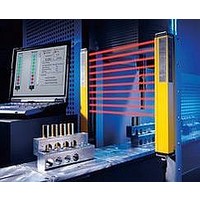F39-EU1E Omron, F39-EU1E Datasheet - Page 606

F39-EU1E
Manufacturer Part Number
F39-EU1E
Description
F3S-B OPTIONAL PROGRAMMING KIT
Manufacturer
Omron
Datasheet
1.F39-EU1E.pdf
(865 pages)
Specifications of F39-EU1E
Leaded Process Compatible
No
Peak Reflow Compatible (260 C)
No
Light Curtain Type
Safety
Lead Free Status / RoHS Status
Contains lead / RoHS non-compliant
Lead Free Status / RoHS Status
Contains lead / RoHS non-compliant
- Current page: 606 of 865
- Download datasheet (35Mb)
Courtesy of Steven Engineering, Inc.-230 Ryan Way, South San Francisco, CA 94080-6370-Main Office: (650) 588-9200-Outside Local Area: (800) 258-9200-www.stevenengineering.com
Switch Operation
Note: An inductive load causes a problem especially in DC circuitry.
Mechanical Conditions for Switch Selection
Electrical Characteristics for Switch Selection
Electrical Conditions
The Switch in actual operation may cause accidents that cannot be
foreseen from the design stage. Therefore, the Switch must be
practically tested before actual use.
When testing the Switch, be sure to apply the actual load
conditions together with the actual operating environment.
All the performance ratings in this catalog are provided under the
following conditions unless otherwise specified.
Inductive load:A minimum power factor of 0.4 (AC) or a
Lamp load:
Motor load:
1. Ambient temperature: 5 C to 35 C
2. Ambient humidity:
An Actuator suitable for the operating method must be selected.
Ask your OMRON representative for details.
Check the operating speed and switching frequency.
1. If the operating speed is extremely low, switching of the
2. If the operating speed is extremely high, the Switch may break
Do not impose excessive force on the Actuator, otherwise the
Actuator may become damaged or not operate correctly.
Make sure that the stroke is set within the suitable range specified
for the model, or otherwise the Switch may break.
The switching load capacity of the Switch greatly varies between
AC and DC. Always be sure to apply the rated load. The control
capacity will drastically drop if it is a DC load. This is because a DC
load has no current zero-cross point, unlike an AC load. Therefore,
if an arc is generated, it may continue comparatively for a long
time. Furthermore, the current direction is always the same, which
results in contact relocation, whereby the contacts easily stick to
each other and do not separate when the surfaces of the contacts
are uneven.
movable contact will become unstable, thus resulting in
incorrect contact or contact welding.
due to shock. If the switching frequency is high, the switching of
the contacts cannot keep up with the switching frequency. Make
sure that the switching frequency is within the rated switching
frequency.
Therefore, it is essential to know the time constants (L/R) of the
load.
(A)
I
Precautions for Correct Use
maximum time constant of 7 ms (DC)
An inrush current 10 times higher than the
normal current
An inrush current 6 times higher than the
normal current
http://www.ia.omron.com/
Solenoids
(Approximately 10 to 20 times higher)
Incandescent
lamps (Approximately 10 to 15 times
higher)
40% to 70%.
Motors
(Approximately
5 to 10 times
higher)
Relays
(Approxi-
mately 4 to 5
times higher)
t
Connections
Power Connection Examples
(Connection of Different Polarities)
Connect the load to the same polarities.
If the load is inductive, counter-electromotive voltage will be
generated. The higher the voltage is, the higher the generated
energy will be, which will increase the abrasion of the contacts and
contact relocation load conditions. Be sure to use the Switch within
the rated conditions.
If the load is a minute voltage or current load, use a Switch
designed for minute loads. The reliability of silver-plated contacts,
which are used by standard Switches, will be insufficient if the load
is a minute voltage or current load.
With a Za contact form, do not contact a single Switch to two power
supplies that are different in polarity or type.
Do not use a circuit that will short-circuit if a fault occurs, otherwise
the charged part may melt and break off.
Application of Switch to a Low-voltage, Low-current Electronic
Circuit.
1. If bouncing or chattering of the contacts results and causes
2. Conventional silver-plated contacts are not suitable for this
3. The contacts of the Switch used for an emergency stop must be
To protect the Switch from damage due to short-circuits, be sure to
connect in series a quick-response fuse with a breaking current 1.5
to 2 times larger than the rated current to the Switch. When
complying with EN certified ratings, use a 10-A IEC 60269-
compliant gI or gG fuse.
Incorrect
Correct
problems, take the following countermeasures.
(a) Insert an integral circuit.
(b) Suppress the generation of pulses from the contact bouncing
application, in which particularly high reliability is required. Use
gold-plated contacts, which are ideal for handling minute
voltage or current loads.
normally closed with a positive opening mechanism.
(c)Copyright OMRON Corporation 2007 All Rights Reserved.
or chattering of the contacts so that it is less than the noise
margin of the load.
Incorrect
NC
NO
NC
NO
L
NC
NO
Precautions for All Switches
L
Incorrect Power Connection
Example
(Connection of Different Power
Supplies)
There is a risk of AC and DC mixing.
NC
NO
Incorrect
AC
DC
NC
NO
L
L
C-4
Related parts for F39-EU1E
Image
Part Number
Description
Manufacturer
Datasheet
Request
R

Part Number:
Description:
Pair Of Flat Mounting Brackets (transmitter & Receiver)
Manufacturer:
Omron

Part Number:
Description:
Pair Of Protective Shrouds (transmitter & Receiver)
Manufacturer:
Omron

Part Number:
Description:
G6S-2GLow Signal Relay
Manufacturer:
Omron Corporation
Datasheet:

Part Number:
Description:
Compact, Low-cost, SSR Switching 5 to 20 A
Manufacturer:
Omron Corporation
Datasheet:

Part Number:
Description:
Manufacturer:
Omron Corporation
Datasheet:










